Contemporary interpretations
Archaeologist Ken Feder has compared weathering on the stone with weathering on New England gravestones whose inscriptions have become indecipherable in the last twenty years, while "the Westford petroglyph, rather miraculously, appears to have improved through time, getting fresher every year with new elements appearing that previously had gone unnoticed. In truth, this simply isn’t possible. The new imagery on the Westford Knight stone either has been recently added or is entirely imaginary, and probably a bit of both." He argues that the Indian petroglyph described in the 19th century probably existed as did the parallel glacial striations, and that later a metal row or awl was used to punch the partial shape of a sword into the rock, and that "The knight in all his regalia resides only in the imagination of Frank Glynn. Other images—for example, a boat, which I could not discern on my visits—may have been added later." [6]
The current interpretation by those who advocate that the feature on the rock is a human figure is that it commemorates a fallen member of the party of Henry Sinclair, a Scottish Earl from Orkney, whom some believe to have made a voyage to the New World in 1398, traveling to Nova Scotia and New England. [7] According to Raymond Ramsey in 1972, the shield carried by the knight in the image was found to support this belief, when "English heraldic experts consulted by Lethbridge definitely identified arms on the shield as belonging to the Sinclairs of Scotland". [8] It has been suggested that the knight is Sir James Gunn, a member of Clan Gunn and a Knight Templar who reportedly traveled with Sinclair. [9] The monument next to the "knight" commemorates this interpretation, stating as fact that Sinclair and his party traveled to present-day Massachusetts. The claim was mentioned in an Encyclopedia of Dubious Archaeology in 2010. [10]
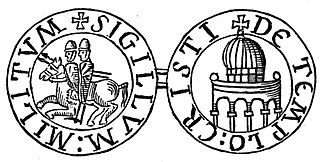
The Poor Fellow-Soldiers of Christ and of the Temple of Solomon, also known as the Order of Solomon's Temple, the Knights Templar, or simply the Templars, was a military order of the Catholic faith, and one of the wealthiest and most popular military orders in Western Christianity. They were founded circa 1119, headquartered on the Temple Mount in Jerusalem, and existed for nearly two centuries during the Middle Ages.

America's Stonehenge is a privately owned tourist attraction and archaeological site consisting of a number of large rocks and stone structures scattered around roughly 30 acres within the town of Salem, New Hampshire, in the United States. It is open to the public for a fee as part of a recreational area which includes snowshoe trails and an alpaca farm.

A petroglyph is an image created by removing part of a rock surface by incising, picking, carving, or abrading, as a form of rock art. Outside North America, scholars often use terms such as "carving", "engraving", or other descriptions of the technique to refer to such images. Petroglyphs, estimated to be 20,000 years old are classified as protected monuments and have been added to the tentative list of UNESCO’s world heritage sites. Petroglyphs are found worldwide, and are often associated with prehistoric peoples. The word comes from the Greek prefix petro-, from πέτρα petra meaning "stone", and γλύφω glýphō meaning "carve", and was originally coined in French as pétroglyphe.
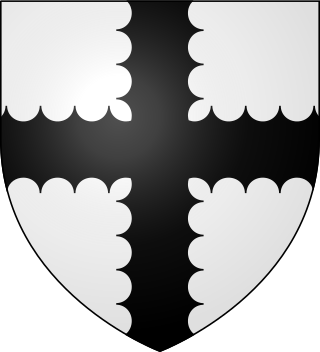
Henry I Sinclair, Earl of Orkney, Lord of Roslin was a Scottish and a Norwegian nobleman. Sinclair held the title Earl of Orkney and was Lord High Admiral of Scotland under the King of Scotland. He was sometimes identified by another spelling of his surname, St. Clair. He was the grandfather of William Sinclair, 1st Earl of Caithness, the builder of Rosslyn Chapel. He is best known today because of a modern legend that he took part in explorations of Greenland and North America almost 100 years before Christopher Columbus. William Thomson, in his book The New History of Orkney, wrote: "It has been Earl Henry's singular fate to enjoy an ever-expanding posthumous reputation which has very little to do with anything he achieved in his lifetime."

Rosslyn Chapel, formerly known as the Collegiate Chapel of St Matthew, is a 15th-century chapel located in the village of Roslin, Midlothian, Scotland.
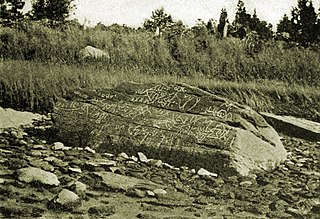
The Dighton Rock is a 40-ton boulder, originally located in the riverbed of the Taunton River at Berkley, Massachusetts. The rock is noted for its petroglyphs, carved designs of ancient and uncertain origin, and the controversy about their creators. In 1963, during construction of a coffer dam, state officials removed the rock from the river for preservation. It was installed in a museum in a nearby park, Dighton Rock State Park. In 1971, it was listed on the National Register of Historic Places (NRHP).

Frauds, Myths, and Mysteries: Science and Pseudoscience in Archaeology is a book by Kenneth L. Feder on the topic of pseudoarchaeology. Feder is an emeritus professor of archaeology at Central Connecticut State University.
Howard Barraclough Fell, better known as Barry Fell, was a professor of invertebrate zoology at the Harvard Museum of Comparative Zoology. While his primary professional research included starfish and sea urchins, Fell is best known for his pseudoarchaeological work in New World epigraphy, arguing that various inscriptions in the Americas are best explained by extensive pre-Columbian contact with Old World civilizations. His writings on epigraphy and archaeology are generally rejected by those mainstream scholars who have considered them.

In archaeology, rock art is human-made markings placed on natural surfaces, typically vertical stone surfaces. A high proportion of surviving historic and prehistoric rock art is found in caves or partly enclosed rock shelters; this type also may be called cave art or parietal art. A global phenomenon, rock art is found in many culturally diverse regions of the world. It has been produced in many contexts throughout human history. In terms of technique, the four main groups are:
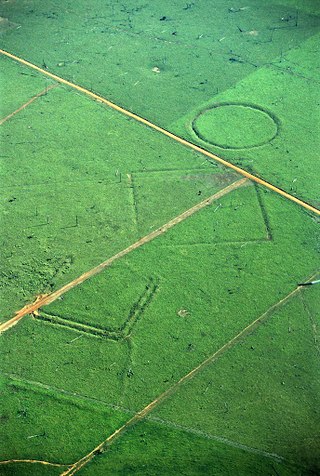
A geoglyph is a large design or motif produced on the ground by durable elements of the landscape, such as stones, stone fragments, gravel, or earth. A positive geoglyph is formed by the arrangement and alignment of materials on the ground in a manner akin to petroforms, while a negative geoglyph is formed by removing part of the natural ground surface to create differently coloured or textured ground in a manner akin to petroglyphs.

Writing-on-Stone Provincial Park is located about 100 kilometres (60 mi) southeast of Lethbridge, Alberta, Canada, or 44 kilometres (30 mi) east of the community of Milk River, and straddles the Milk River itself. It is one of the largest areas of protected prairie in the Alberta park system, and serves as both a nature preserve and protection for many First Nations (indigenous) rock carvings and paintings. The park is sacred to the Blackfoot and many other aboriginal tribes.

Royston Cave is an artificial cave located in Katherine's Yard, Melbourn Street, Royston, England. It is located beneath the crossroads formed by Ermine Street and the Icknield Way. It is protected as both a scheduled ancient monument and Grade I listed building. It has been speculated that it was used by the Knights Templar, who founded nearby Baldock, but this is unlikely, despite its enormous popular appeal. There are numerous theories about the Cave covering Freemasons and Templars as well as possibilities that the Cave was a prison or an anchorite cell. However, none of these theories have enough hard evidence to warrant their being adopted by the Cave Trust. It is open to the public in the summer months on Saturday, Sunday and Bank Holiday afternoons between Easter and October.

The Knights Templar, full name The United Religious, Military and Masonic Orders of the Temple and of St John of Jerusalem, Palestine, Rhodes and Malta, is a fraternal order affiliated with Freemasonry. Unlike the initial degrees conferred in a regular Masonic Lodge, which only require a belief in a Supreme Being regardless of religious affiliation, the Knights Templar is one of several additional Masonic Orders in which membership is open only to Freemasons who profess a belief in Christianity. One of the obligations entrants to the order are required to declare is to protect and defend the Christian faith. The word "United" in its full title indicates that more than one historical tradition and more than one actual order are jointly controlled within this system. The individual orders 'united' within this system are principally the Knights of the Temple, the Knights of Malta, the Knights of St Paul, and only within the York Rite, the Knights of the Red Cross.
The Bourne Stone is an archaeological curiosity located in the town of Bourne, Massachusetts. The stone is a 300-pound chunk of granite, upon which two lines of carvings were made.
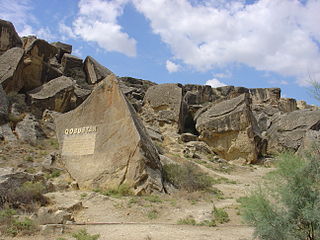
Gobustan State Historical and Cultural Reserve is located west of the settlement of Gobustan, about 40 miles (64 km) southwest of the centre of Baku. It was established in 1966, when the area was declared a national historical landmark of Azerbaijan in an attempt to preserve the prehistoric rock carvings, mud volcanoes and musical stones in the region.

Sydney rock engravings, or Sydney rock art, are a form of Australian Aboriginal rock art in the sandstone around Sydney, New South Wales, Australia, that consist of carefully drawn images of people, animals, or symbols. Many thousands of such engravings are known to exist in the Sydney region, although the locations of most are not publicised to prevent damage by vandalism, and to retain their sanctity, as they are still regarded as sacred sites by Indigenous Australians. There are two art environments in Sydney Basin, rock shelters and engraving sites.
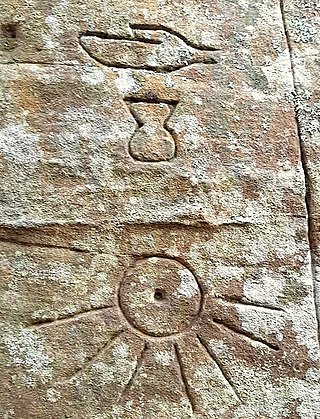
The Gosford Glyphs, also known as Kariong Hieroglyphs, are a group of approximately 300 Egyptian-style hieroglyphs located in Kariong, Australia. They are found in an area known for its Aboriginal petroglyphs, just between Gosford and Woy Woy, New South Wales, within the Brisbane Water National Park. The glyphs have since been dismissed as a hoax by authorities and academics after their discovery in the 1970s, but there are still attempts to prove the belief that they were carved by the ancient Egyptians about 4,500 years ago.

Istrehågan is an ancient monument at Jåberg on the Sandefjord-Larvik border in Vestfold og Telemark, Norway. It is home to some of the largest stone settings in the Nordic countries. Nearby Haugen farm in Sandefjord is home to Vestfold County's largest petroglyph site. The rock carvings at Haugen farm are Vestfold County's oldest ancient monument. It is an ancient burial ground which dates to the time of the Roman Iron Age around 1500-500 BCE. It is located two kilometers northwest of Hemskilen Nature Preserve in a forest known as Marumskogen.

Gobustan Rock Art represents flora and fauna, hunting, lifestyles, and culture of pre-historic and medieval periods of time. The carvings on the rocks illustrates primitive men, ritual dances, men with lances in their hands, animals, bull fights, camel caravans, and pictures of the sun and stars. The date of these carvings goes back to 5.000 – 20.000 years before present.

The Church of St Edmund King and Martyr, Kellington, is a grade I listed 12th century church in the village of Kellington, North Yorkshire, England. Excavations at the site have revealed the 14th century tomb related to the Knights Templar, and in the 1990s, the foundations of the church were underpinned because of possible subsidence effects from the nearby Kellingley Colliery.



















